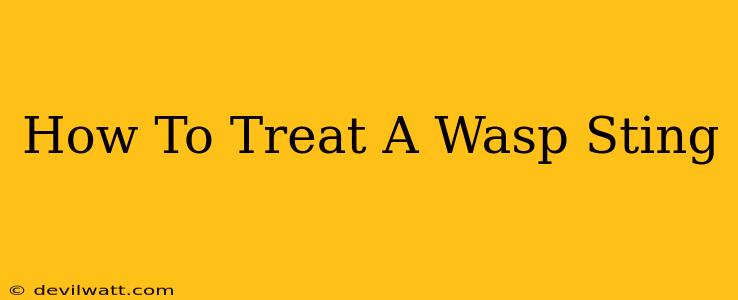Wasp stings are a common summertime nuisance, causing pain, swelling, and sometimes even a serious allergic reaction. Knowing how to treat a wasp sting effectively can significantly reduce discomfort and prevent complications. This comprehensive guide will walk you through the best practices for treating wasp stings, from immediate first aid to managing severe reactions.
Understanding Wasp Stings
Before diving into treatment, let's understand what happens when a wasp stings. Wasps, unlike bees, can sting multiple times because their stinger isn't barbed. When a wasp stings, it injects venom containing proteins that trigger an inflammatory response in the body. This response causes the characteristic pain, swelling, redness, and itching.
What to Expect After a Wasp Sting:
- Immediate Pain: A sharp, burning sensation at the sting site.
- Swelling: The area around the sting will swell, often becoming quite noticeable.
- Redness: Redness will develop around the sting, spreading outwards.
- Itching: Intense itching is common, sometimes lasting for several hours or days.
First Aid for Wasp Stings: Immediate Action
Immediate action is crucial in minimizing discomfort and preventing complications. Here's what to do:
1. Remove the Stinger (If Present):
Unlike bees, wasps often leave their stinger behind. Carefully scrape the stinger away with a flat, hard object like a credit card or the edge of a knife. Avoid squeezing the stinger, as this can release more venom.
2. Clean the Area:
Wash the sting site thoroughly with soap and water to remove any remaining venom or dirt. This simple step can significantly reduce the risk of infection.
3. Apply a Cold Compress:
Applying a cold compress (ice pack wrapped in a thin cloth) to the affected area can help reduce pain, swelling, and inflammation. Apply for 10-15 minutes at a time, several times a day.
4. Elevate the Affected Limb (If Possible):
Elevating the affected limb, if the sting is on an arm or leg, can help reduce swelling.
Home Remedies for Wasp Sting Pain Relief:
Several home remedies can provide additional pain relief and reduce inflammation:
- Baking Soda Paste: Make a paste of baking soda and water and apply it to the sting site. This can help neutralize the venom.
- Apple Cider Vinegar: Applying apple cider vinegar to the sting can also help reduce pain and swelling.
- Tea Bags: A cooled, damp tea bag applied to the sting can help reduce swelling and pain due to the tannins in the tea.
When to Seek Medical Attention:
While most wasp stings are manageable at home, some situations require immediate medical attention:
- Multiple Stings: Multiple stings can lead to a more severe reaction.
- Allergic Reaction: Signs of an allergic reaction include difficulty breathing, swelling of the face or throat, dizziness, hives, and nausea. This is a medical emergency requiring immediate treatment.
- Severe Pain or Swelling: If the pain or swelling is excessive or doesn't improve after a few days, seek medical attention.
- Infection: Signs of infection include increased pain, swelling, pus, and red streaks extending from the sting site.
Preventing Wasp Stings:
Prevention is always better than cure. Here are some tips to avoid wasp stings:
- Avoid bright colors and perfumes: Wasps are attracted to bright colors and sweet scents.
- Keep food and drinks covered: Avoid leaving food and drinks uncovered, especially outdoors.
- Be cautious near nests: If you see a wasp nest, avoid approaching it. Contact pest control for removal if necessary.
- Wear appropriate clothing: When outdoors, wear long sleeves and pants to minimize exposed skin.
This guide provides comprehensive information on treating wasp stings. Remember, always prioritize safety and seek medical attention when necessary. By following these steps, you can effectively manage wasp stings and minimize discomfort.

